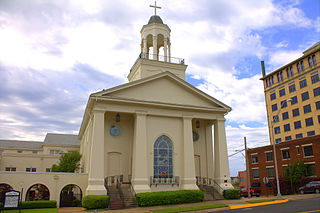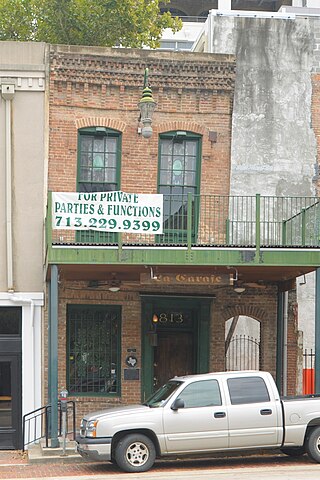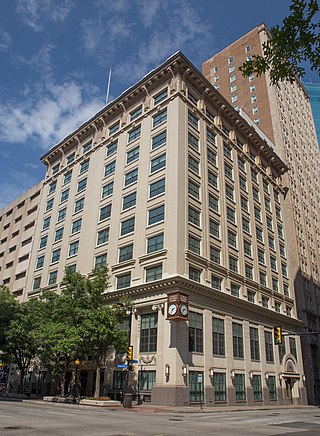
The Bishop's Palace, also known as Gresham's Castle, is an ornate 19,082 square feet (1,772.8 m2) Victorian-style house, located on Broadway and 14th Street in the East End Historic District of Galveston, Texas.

The Dallas County Courthouse, built in 1892 of red sandstone with rusticated marble accents, is a historic governmental building located at 100 South Houston Street in Dallas, Texas. Also known as the Old Red Courthouse, it became the Old Red Museum, a local history museum, in 2007. It was designed in the Richardsonian Romanesque style of architecture by architect Max A. Orlopp, Jr. of the Little Rock, Arkansas based firm Orlopp & Kusener. In 1966 it was replaced by a newer courthouse building nearby. On December 12, 1976, it was added to the National Register of Historic Places. In 2005–2007 the building was renovated.

The Julia Ideson Building is a Houston Public Library facility in Downtown Houston, Texas, United States. It is named for Julia Bedford Ideson, who served as the system's first head librarian for 40 years.

The East End Historic District encompasses a large 19th-century residential area in eastern Galveston, Texas. The area is roughly bounded by Broadway to the south, Market St to the north, 19th St to the west, and 9th street to the east. The area has one of the best-preserved and largest concentrations of 19th-century residential architecture in Texas. It was developed mainly at a time when Galveston was the state's preeminent port. The historic district, designated locally in 1970, was placed on the National Register of Historic Places in 1975 and declared a National Historic Landmark in 1976.

Mrs. Sam Houston House is a historic house on Farm to Market Road 390 in Independence, Texas. Sometimes known as the Root house, this Greek Revival house was built probably around 1855. Margaret Lea Houston, the widow of politician and Texas statesman Sam Houston, bought the house in 1864 from Major Eber Cave, a family friend. She lived in it during her final years until her death in 1867. The property was listed on the National Register of Historic Places in 1970 as the "Mrs. Sam Houston House," notable for its association with her.

Grace Episcopal Church is a historic church at 1115 36th Street in Galveston, Texas. It was built in 1894 and added to the National Register in 1975.

First Methodist Church is a historic Methodist church at 300 E. Houston Street in Marshall, Texas. It has also been known as First United Methodist Church and as Methodist Episcopal Church of South Marshall. It is a stuccoed brick Greek Revival-style church with a portico having four monumental square columns; such architecture is rare in Texas.

The Colorado County Courthouse, built in 1890, is a historic government building located at 400 Spring Street in Columbus, Colorado County, Texas. It was designed in a combination of Classical Revival and Italianate styles of architecture by noted Houston architect Eugene T. Heiner, who designed at least nine other Texas courthouses. Colorado County's fourth courthouse, it originally had a central bell tower which was replaced before 1939 by a central domed Tiffany-style skylight. On July 12, 1976, it was added to the National Register of Historic Places. It was renovated in 2013, when historic colors were restored. It is still in use today as a courthouse.

The Cotton Exchange Building is a historic building located in downtown Houston. Built in 1884, it is listed on the National Register of Historic Places. The Houston Cotton Exchange and Board of Trade commissioned local architect Eugene Heiner to design a three-story building on Travis Street at the corner of Franklin in Houston. In 1907, the building was remodeled and a fourth floor added. The Houston Cotton Exchange continued to use the building until it moved its operations to a new building several blocks away at Prairie and Caroline in 1924.

This is a list of the National Register of Historic Places listings in Houston County, Texas.

Kennedy Bakery, located at 813 Congress Street in Houston, Texas, was listed on the National Register of Historic Places on July 27, 1979. The historic property in downtown Houston faces Market Square and lies within the Main Street Market Square Historic District. It is probably the "oldest Houston building existing on its original site."

The Texas Company Building, located at 1111 Rusk in Houston, Texas, was listed on the National Register of Historic Places on April 2, 2003.

The Paul Building is a high-rise office building located at 1018 Preston Avenue in Houston, Texas. It was listed on the National Register of Historic Places on April 6, 1979. Completed in 1907, the building has been home to a wide range of businesses and professionals. It housed the United States District Court in 1910, and with its proximity to the county courthouse, it became a popular location for attorneys. Its tenants have also included a newspaper, and the Y.M.C.A. The building changed its name to the Hoffman Building in 1918 and then to the Turnbow Building in 1927. It has been known as the Republic Building since 1923.

The Oriental Textile Mill, located at 2201 Lawrence Street in the Houston Heights neighborhood of Houston, Texas, was listed on the National Register of Historic Places on June 22, 1983.

The Scanlan Building, located at 405 Main Street in Houston, Texas, is an eleven-story, 76,403sq.ft building completed in 1909. Built on the site of the first official home of the president of the Republic of Texas, it was the first building of its size and type to be designed by a major national architect to be built in Houston, and set the style for future construction in the area. It is the only known office building in Houston which was designed by D.H. Burnham & Company of Chicago. The building was the first to be built higher than ten stories, breaking the limit preferred by Houston developer Jesse H. Jones.

The James Bute Company Warehouse, located at 711 William Street in Houston, Texas, was listed on the National Register of Historic Places on July 7, 1994. The Bute Paint Company, founded by James Bute, operated from 1867 until 1990. Its warehouse building on William Street was built in 1909. Abandoned after 1990, the property was converted to loft apartments in 1993.

First National Bank Building, at 711 Houston St. in Fort Worth, Texas, was built in 1910. It was designed by Sanguinet & Staats with Wyatt C. Hedrick. It has also been known as Baker Building and as Bob R. Simpson Building.

The Harris County Courthouse of 1910 is one of the courthouse buildings operated by the Harris County, Texas government, in Downtown Houston. It is in the Classical Revival architectural style and has six stories. Two courtrooms inside are two stories each. It was listed on the National Register of Historic Places on May 13, 1981.

The Simon and Mamie Minchen House is a single-family residence in the Ormond Place subdivision in Boulevard Oaks, Houston. It is listed on the National Register of Historic Places, #00001496, as of December 7, 2000. It is also a Recorded Texas Historic Landmark and a Protected Houston Landmark. The two-story house uses an Italian Renaissance architectural style, and it also has a garage of the same height, which can hold three cars. The property also has a residence formerly used for servants.

The Houston Street Viaduct is a viaduct in Dallas, Texas, that carries Houston Street across the Trinity River, connecting Downtown Dallas and Oak Cliff. Designed by Ira G. Hedrick, it was built in 1911, and is listed on the National Register of Historic Places.





















